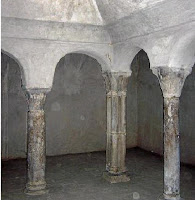Old
Valencia Jewish district
The old Jewry of Valencia, called
El Call, after the conquest
of Jaime I (1236), spread along the northern side of the present
Calle de la Paz (Peace Street) to the south. Among the most
remarkable buildings from jews past we can highlight the bathrooms
and the Butcher's, and near the present “Plaza de la reina” was
located the Jewish Market or
Suk.
Map of Islamic Valencia (Sanchis Guarner)
Following
this map, entering the portal de la Figuera we have at the map the
Jewish baths just below.
Jews baths were of two types, public and
rituals (in Hebrew called miqweh) and they represent an institution
both hygienic and religious.
We must then diferenciate between
public and ritual bath (Miqweh) within Judaism.
Valencia Medieval District at Medieval Time
Public
baths in many parts of Spain were know as a Hamman , and the
institution was shared betwen jews and muslims, and afterwards wiht
christians too. The Jewish Quarter of Valencia were indeed very
similar to the Arab baths and the late one also influenced the
Christian Bath Institution still surviving in the city, with their
warm rooms in the center and both hot and cold at both sides. In Valencia we had of this type the well knowb "Baños del Almirante ((Admiral Baths) of Christian period (1320).

Similars and olders in
Medieval Spain, known as Sefarad, are those of Saragoza, of jewish origins and arabic influences, with its columns much like those of
our "Baños del Almirante". These baths of Zaragoza are cited in some
documents from the thirteenth century, the earliest reference
corresponding to 1266. They are located in the Jewish quarter
opposite the fortress called "Castle of the Jews" (a complex with jail,
synagogue, hospital, butchers). Today it remains only a part of the
baths : a room, of substantially rectangular section with vaulted
ceiling, covered with 8 point-stars lighting windows. This large room could communicate with another room colder vaulted with a two arched
section perhaps the caldarium and frigidarium. They are XIIIth century
Mudejar (moors living under christian rule) with formal elements of christian Cistercian style.
Jews Baths of Saragosa Small Room
The next
step was the ritual Bath or Miqweh. To participate in the
ritual bath, the Jewish oral tradition of the Talmud requires the
cleaning of any physical dirt, before gaining admission to pass the
second barrier of physical and spiritual purification. The ritual
bath is attached to the synagogue. Oral Law speaks about natural
waters of "sources and wells" (Leviticus 11:36). To
participate in the liturgy of the Jewish Temple and Jewish piety
ceremonies one had to be purify of such contamination as the
menstrual period by means of the immersion of the whole body in a
ritual bath. The Talmud describes how it should be built a “Mikweh”
and its conditions. Therefore, the entrance to the public baths
preceds the miqweh immersion. In biblical times John the
Baptist reshape this purifying sense to penitential one and Jesus
focused on the personal sanctification. Archaeologists have found in
Qumran baths from I century b.C and in the Judeo-Christian period
others have been discovered in Nazareth, with seven steps of descent
and ascent that symbolizes the new creation of the person .

Ancient Miqweh at the Holy Land
The
source of ritual bath water should be running canals or rain water
when gathered in an underground cistern.
The
characteristics of the ritual bath or Miqweh can be observed which is
in the town of Besalu, near Girona. It is the only of its kind
discovered in the Iberian Peninsula and of the few known in
Europe.
 Miqweh of Besalu
Miqweh of Besalu
Now we are already able to answer about two questions: Was
there a public jew bathhouse in Valencia? Yes and possibly it
followed the pattern of Zaragoza Hammam and in Valencia were
it was located near the Portal de la Figuera.
Did we
have a Mikweh in Valencia? We do not have the security whether about
this point nor about the site, but they would probably located
between the public baths and the synagogue. In the village of
Sagunto, 30 km north to Valencia, a supposed miqweh house has been
discovered, dating from the fourteenth century, in the so called
Casa dels Bereguer. The room is vaulted and retains the ancient
seven steps symbol, and the tank that was used to collect rainwater.
Supposed Miqweh of Sagunto


















